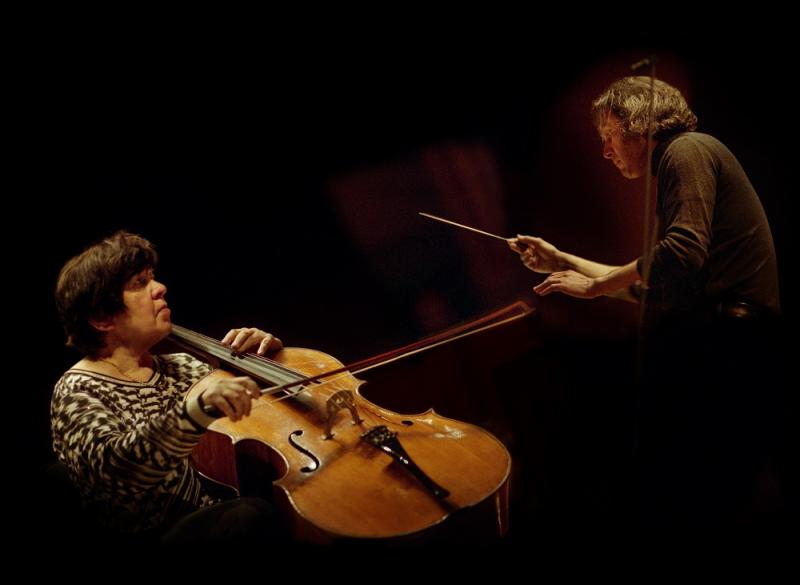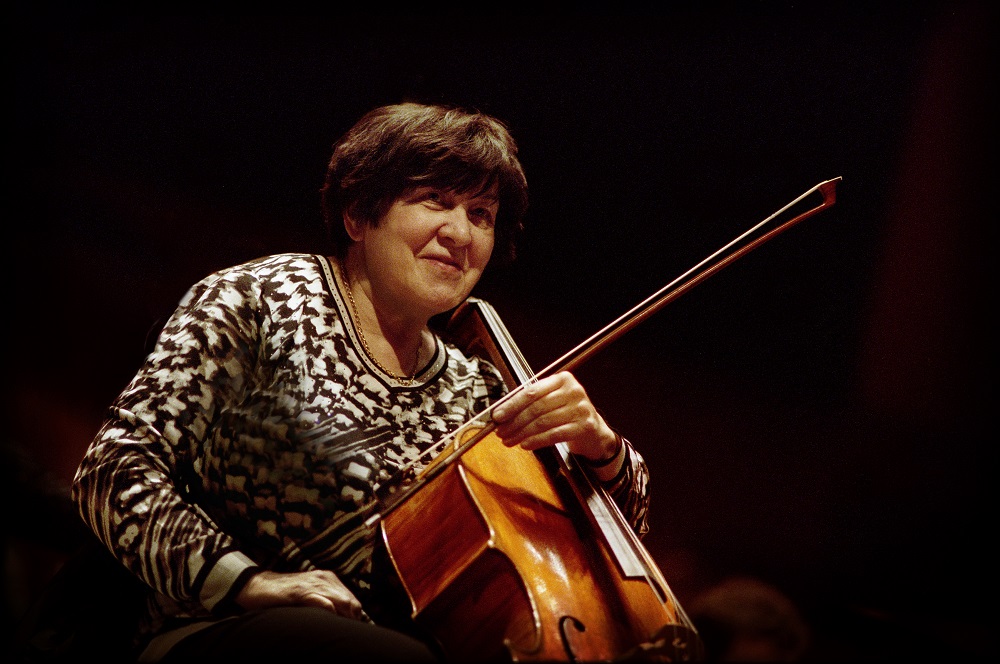Gutman, LPO, Jurowski, RFH | reviews, news & interviews
Gutman, LPO, Jurowski, RFH
Gutman, LPO, Jurowski, RFH
A legendary cellist and a long Bruckner original face difficulties

Risk-taking is what gives so many of Vladimir Jurowski's concerts with the London Philharmonic Orchestra their special savour. But did two risks for last night's programme pay off? I was as excited as many Russians and hardcore Russophiles at the rare visit of legendary 73-year-old cellist Natalia Gutman, and it could only be interesting to hear the little-heard, hour-long first version of Bruckner's Third Symphony.
Gutman's recording of the two Shostakovich Cello Concertos is up there with the interpretations of her mentor Rostropovich, and she has another claim to making history: Alfred Schnittke wrote his First Cello Concerto and his masterpiece of a Cello Sonata for her. It was a canny idea to place Schnittke's terrifying Pianissimo of 1967-8 first. You could of course take those little jabs of sound which accumulate over one long crescendo as the thousand lashes of life in Brezhnev's Soviet Union, but Schnittke's cited source, if more local, is even more alarming: Kafka's In the Penal Colony, where a machine which slowly pricks the names of the convicts onto their backs claims the commander as its victim. The climax, in which as Schnittke put it, "a mustily fomenting mass...finally rises up and explodes", was inexorably gauged here.
Nerves were already raw at the intelligence that Gutman (pictured below) had been suffering severe back problems – hence the cushion on her seat – and that the rehearsal had been touch-and-go. Bent over her cello with the trademark mop of black hair covering her eyes, and her face in shadow, she launched into the endgame of Shostakovich's Second Cello Concerto – a more philosophical work than the First – as if playing to herself.
 This had the capacity to be a great Shakespearean monologue, the kind of seriousness we'd missed in Jurowski's neat and generously offered 6pm whizz through Shostakovich's first, vaudevillesque incidental music for a farcical 1932 Hamlet (more than promising solos here from LPO Foyle Future Firsts flautist Bronte Hudnott and clarinettist Som Howie). What Gutman could no longer extend to was the fullest of voices; in intense double stopping the pitch could falter. The centre held thanks to the keen listening and sound-matching of the orchestral players, which started with intense cellos and basses – and more watching of Jurowski than I've seen from the LPO before.
This had the capacity to be a great Shakespearean monologue, the kind of seriousness we'd missed in Jurowski's neat and generously offered 6pm whizz through Shostakovich's first, vaudevillesque incidental music for a farcical 1932 Hamlet (more than promising solos here from LPO Foyle Future Firsts flautist Bronte Hudnott and clarinettist Som Howie). What Gutman could no longer extend to was the fullest of voices; in intense double stopping the pitch could falter. The centre held thanks to the keen listening and sound-matching of the orchestral players, which started with intense cellos and basses – and more watching of Jurowski than I've seen from the LPO before.
Rhythmically natural, more hit-and-miss pitchwise, Gutman shone a beautiful light on the poignant, classical ritornellos of the complex finale – half Brittenesque lullaby-lament (the two composers knew each other well by 1966), half tiptoe dance with death. The two orchestral fanfares and monster-stomp which ushered in percussion-backed cadenzas were aptly blinding, the final shadowplay haunting as it must be. The whole just about came off, but it was not a comfortable experience to watch – and maybe that's right for such music.
Jurowski made sure that each of the string groups had its cohesive soundDiscomfort in Bruckner, for this listener at least, sometimes turns to exasperation. Surely none of his symphonies has more of those masses followed by voids than the Third; explain them how you will, inappropriate cathedral analogies included – certainly a more resonant acoustic than that of the Festival Hall might help – but their awkwardness soon ceases to be a virtue when three of the movements run at such length in the 1873 original. I'd come to know the work through the standard revision, about a quarter of an hour shorter, and it was hard to hear the point of extensive developments when they're on a hiding to nowhere.
No doubt it's good for the orchestra to have so much sectional exposure; Juliette Bausor crowned the flute ensemble with ineffable air and space, the horns had exactly that right Austro-German darkness, and Jurowski made sure that each of the string groups shone with a cohesive sound: the violas sounded amazing in the hymns of the slow movement, and suitably earthy in the Ländler at the heart of the Scherzo, where the second violins also get their moment in the sun. It was good to hear the two homages to the "Magic Fire Music" of Wagner's Die Walküre, which vanished from subsequent revisions (not that Bruckner seems to have grasped the dramaturgy; at a performance he apparently asked why they were setting fire to Brünnhilde).
The polka-meets-chorale sequence of the finale made a winsome sequence too. But all that comical flaring around it? Worth it, perhaps, to hear Paul Beniston, so perfect a trumpeter in the symphony's misty opening, get his unearned apotheosis after clunky reminiscences of other movements from earlier in the symphony. Still, I couldn't help thinking it might have been better if Bruckner had given us four symphonies less and whole sequences of Austrian dances instead. Maybe I just lack all sense of the Brucknerian sublime, but even when it had such height and depth in ensembles as here, I just didn't buy it.
rating
Share this article
The future of Arts Journalism
You can stop theartsdesk.com closing!
We urgently need financing to survive. Our fundraising drive has thus far raised £49,000 but we need to reach £100,000 or we will be forced to close. Please contribute here: https://gofund.me/c3f6033d
And if you can forward this information to anyone who might assist, we’d be grateful.

Subscribe to theartsdesk.com
Thank you for continuing to read our work on theartsdesk.com. For unlimited access to every article in its entirety, including our archive of more than 15,000 pieces, we're asking for £5 per month or £40 per year. We feel it's a very good deal, and hope you do too.
To take a subscription now simply click here.
And if you're looking for that extra gift for a friend or family member, why not treat them to a theartsdesk.com gift subscription?
more Classical music
 Echo Vocal Ensemble, Latto, Union Chapel review - eclectic choral programme garlanded with dance
Beautiful singing at the heart of an imaginative and stylistically varied concert
Echo Vocal Ensemble, Latto, Union Chapel review - eclectic choral programme garlanded with dance
Beautiful singing at the heart of an imaginative and stylistically varied concert
 Scott, Irish Baroque Orchestra, Whelan, RIAM, Dublin review - towards a Mozart masterpiece
Characteristic joy and enlightenment from this team, but a valveless horn brings problems
Scott, Irish Baroque Orchestra, Whelan, RIAM, Dublin review - towards a Mozart masterpiece
Characteristic joy and enlightenment from this team, but a valveless horn brings problems
 Classical CDs: Voice flutes, flugelhorns and froth
Baroque sonatas, English orchestral music and an emotionally-charged vocal recital
Classical CDs: Voice flutes, flugelhorns and froth
Baroque sonatas, English orchestral music and an emotionally-charged vocal recital
 Kanneh-Mason, Britten Sinfonia, Shave, Milton Court - a grin and a big beaming smile
A pair of striking contemporary pieces alongside two old favourites
Kanneh-Mason, Britten Sinfonia, Shave, Milton Court - a grin and a big beaming smile
A pair of striking contemporary pieces alongside two old favourites
 theartsdesk at the New Ross Piano Festival - Finghin Collins’ musical rainbow
From revelatory Bach played with astounding maturity by a 22 year old to four-hand jazz
theartsdesk at the New Ross Piano Festival - Finghin Collins’ musical rainbow
From revelatory Bach played with astounding maturity by a 22 year old to four-hand jazz
 First Person: Manchester Camerata's Head of Artistic Planning Clara Marshall Cawley on questioning the status quo
Five days of free events with all sorts of audiences around Manchester starts tomorrow
First Person: Manchester Camerata's Head of Artistic Planning Clara Marshall Cawley on questioning the status quo
Five days of free events with all sorts of audiences around Manchester starts tomorrow
 Goldscheider, Brother Tree Sound, Kings Place review - music of hope from a young composer
Unusual combination of horn, strings and electronics makes for some intriguing listening
Goldscheider, Brother Tree Sound, Kings Place review - music of hope from a young composer
Unusual combination of horn, strings and electronics makes for some intriguing listening
 theartsdesk Q&A: composer Donghoon Shin on his new concerto for pianist Seong-Jin Cho
Classical music makes its debut at London's K-Music Festival
theartsdesk Q&A: composer Donghoon Shin on his new concerto for pianist Seong-Jin Cho
Classical music makes its debut at London's K-Music Festival
 Helleur-Simcock, Hallé, Wong, Bridgewater Hall, Manchester review - moving lyricism in Elgar’s concerto
Season opener brings lyrical beauty, crisp confidence and a proper Romantic wallow
Helleur-Simcock, Hallé, Wong, Bridgewater Hall, Manchester review - moving lyricism in Elgar’s concerto
Season opener brings lyrical beauty, crisp confidence and a proper Romantic wallow
 Kohout, Spence, Braun, Manchester Camerata, Huth, RNCM, Manchester review - joy, insight, imagination and unanimity
Celebration of the past with stars of the future at the Royal Northern College
Kohout, Spence, Braun, Manchester Camerata, Huth, RNCM, Manchester review - joy, insight, imagination and unanimity
Celebration of the past with stars of the future at the Royal Northern College

Add comment